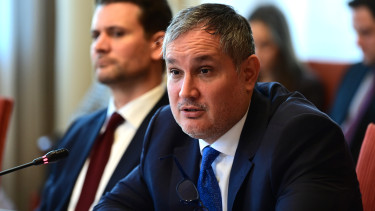Hungary starts re-opening the economy - Is it a good idea?

The 2.5 millionth COVID-19 vaccine has been administered today
Hungary's Prime Minister Viktor Orbán has announced on Tuesday evening that the re-opening of the economy is starting on Wednesday, as a milestone of 2.5 million people vaccinated against coronavirus (SARS-CoV-2) has been reached. Strict(er) lockdown measures were implemented on 8 March, originally for two weeks.
Orbán has made re-opening conditional to this figure. Not to the number of new confirmed cases, coronavirus patients in hospitals or on ventilators, deaths, no. The 'milestone' was 2.5 million people that are supposed to be protected from coronavirus. Spoiler alert: they're not.

The goal was set by PM Orbán, seemingly arbitrarily, but later he (sort of) explained that this number
has been designated for us by moral law, because the country must not be relaunched until those most at risk of dying have been vaccinated: until they’ve been removed from a situation in which their lives are in immediate danger. This means people over the age of 65.
In the meantime, Hungary is close second to Czechia in terms of coronavirus deaths per one million population, according to government data. Orbán’s confidence stems from Hungary being a European champion in vaccine uptake, and from the decreasing number of new confirmed COVID-19 cases.
While the former can be regarded as a legitimate source of pride, it sadly shifts focus not only from the dreadful mortality statistics, but also from the latter statistics that may be even more important, particularly as it is deceptive.
In the following, using simple calculations, we put the spotlight on the vaccination campaign, the re-opening strategy, and mortality statistics. The results may be daunting but our goal is not to cause panic, rather than to clear up a few things, increase the awareness of the population, and possibly save lives.
Vaccine rollout: A+
According to the latest ECDC statistics on Covid-19 vaccine rollout, nearly 65% of people in the 70-79 age group have been vaccinated against COVID-19, and the ratio is almost 60% in the 80+ group and over 43% in the 60-69 group.

The pace of the vaccination campaign is laudable - Hungary is the only EU member state which uses Russian and Chinese vaccines that have not been approved by the European Medicines Agency (EMA) - and is also promising regarding the future.
As we have highlighted several times, the key issue will not be the availability of vaccines, rather than people's willingness to get their jabs. With the UK variant the herd immunity threshold is now much higher than 60%, and Hungary is still extremely far from having even 60% of the population protected from COVID-19 either via vaccination or infection. (See more about this below,)

The other reassuring factor the cabinet relies on is the decrease in the number of new daily confirmed COVID-19 cases. The problem with that… well, the main problem is that we have fewer cases because fewer tests are performed, while the positivity rate remains extremely high (17% reported today, but over 20-22% in the days before).
Experts' views on today's achievement
- Virologist Miklós Rusvai said re-opening linked to 2.5 million inoculated people is risky, and the government should make it conditional to epidemiological data instead.
- János Szlávik, head infectologist at the Dél-pesti Centrumkórház, said we should not lay back, as Hungary needs a lot more than 2.5 million people vaccinated against COVID-19.
- Ernő Duda, associate professor at the University of Szeged, told 168.hu earlier that re-opening would be safe with at least 3.5 million vaccinated people.
- Béla Merkely, rector of Semmelweis Medical University, said 2.5 million was a "good objective", but everyone would be safe if there were 5 million people vaccinated against COVID-19.
Government officials/experts have highlighted that the concentration of coronavirus RNA in wastewater is stagnating as a reassuring sign of a receding pandemic. There are various issues with the increase of SARS-CoV-2 RNA in sewage with the increase in reported COVID-19 prevalence, but in our case the main issue is the weather. It seems that Hungarian experts appear to forget a simple correlation between the temperature of sewage and coronavirus concentration in sewage, which is that the warmer the sewage gets the smaller the concentration should be if the pandemic was indeed in retreat as they say it is.
Hungary’s Chief Medical Officer Cecília Müller has repeatedly warned that the UK variant can cause severe symptoms and young people are no exception. In fact, she said on Tuesday that a “large part” of those treated with coronavirus infection in hospital are young.
And what is going to be re-opened on 19 April? Yes, schools. Elementary and secondary schools and nurseries. Well done.
About the first stage of re-opening
There will be a curfew between 10 P.M. and 5 A.M. instead of 8 P.M. and 5 A.M.
Stores will be allowed to remain open from 5 A.M. to 9.30 P.M. instead of 7 P.M.
The temporary closure of service providers will end and all shops, including hairdressers and beauty salons, will be allowed to re-open, but with restrictions.
Food services can still not re-open fully, and food can be offered only for takeout. Customers may enter the premises only for the duration of their order and service.
In stores, the number of customers present at the same time is maximised at one per every ten square metres.
Hotels will remain closed to guests.
Once teachers are vaccinated, elementary and secondary schools and nurseries will re-open on 19 April. Details of the first stage of the re-opening will be published in the Official Gazette.
The whole re-opening strategy gets legitimised by the results of the so-called ‘national consultation’ which Orbán also likes to cite as one of the key reasons behind the government’s pandemic-related decisions. Last Friday, he said 600,000 Hungarians expressed their views about re-opening in the latest round of national consultations.
We know exactly what they think. A gradual re-opening is needed; schools have to be opened first […].
The problem is that none of the questions were about the re-opening of schools, which has an exceedingly simple explanation: schools were not closed when the national consultation was launched.
But let’s be clear. If the national consultation could be taken seriously, its results were made public, and it actually reflected the views of the Hungarian people, we would find that people in general do not sense how serious the pandemic situation is. They do want the economy to re-open. It’s an economic policy issue, but also a psychological issue and a question of tolerance and attitude.
Doing the math
Let’s do a simple calculation.
Official data published on Tuesday morning show that 22,098 people have died of coronavirus-related diseases in Hungary since the outbreak last spring. (Unofficially, this is estimated to be over 30,000 but let’s not get there just yet.) It is also a fact that in the second wave (autumn, winter 2020, January 2021), about 20% of those hospitalised with COVID-19 diagnosis died, and 80% recovered. The population of Hungary is about 10 million.
If we accept 22,000 as 20% of X, then X equals 110,000.
If we accept 30,000 as 20% of X, then X equals 150,000.
This means that 110,000 to 150,000 Hungarians had to have been treated in hospital with positive coronavirus tests so far.
We also know that 5 to 10% of people infected with coronavirus require treatment in hospital, which implies that
- 110,000 is the 5% of X --- X = 2.2 million infections
- 110,000 is the 10% of X --- X = 1.1 million infections
- 150,000 is the 5% of X ---- X = 3 million infections
- 150,000 is the 10% of X ---- X = 1.5 million infections
As for those that have been vaccinated, it takes 10-14 days after the second dose to build full protection against coronavirus. About 923,000 people have received their 2nd jab so far, but 10-14 days or more since then have passed only for about 600,000 of them.
Let’s be optimistic here and say that 2.5-2.8 million people are now (temporarily) protected from coronavirus.
This means that we need about three times as many for an appropriate level of herd immunity. This leads to a dramatic conclusion, which is three times as many deaths, i.e. 22,000 x 3 = 66,000 or 30,000 x 3 = 90,000. With the re-opening and without further restrictions instead, that is. Hospitals are already operating close to reaching capacity, and without proper treatment chances of survival will deteriorate drastically even for the 80% that had previously survived. The re-opening of the economy risks a scenario where up to 50% of them could die. Applying the above figures: 110,000 to 150,000 infections x 3 = 330,000 to 450,000 infected people. If half of them die, that 165,000 to 225,000 deaths.
Hungary has 22,000+ or (based on demographic statistics issued by KSH) more likely 35,000+ deaths at present, and 60,000 may be inevitable, but it would be horrific to go up to 100,000, and it can be avoided.
The government may want to listen to voices warning against the (premature) re-opening of nurseries, schools, stores and services. These can and should wait.
What next?
Here’s more food for thought
About four million Hungarians registered for a COVID-19 vaccine so far. Herd immunity with the more contagious and more deadly UK variant is somewhere between 80% and 90%. Let’s say 85%, which is 8.5 million people.
About 20% of the population are under 18 who do not get vaccinated under current rules, and the earliest their inoculation can start is the autumn of 2021.
There are no studies yet as to how long recovered and vaccinated people are protected from coronavirus, we know only that vaccines prevent severe symptoms and death. Vaccines have not been designed to give people superpowers against coronavirus. Even if you’re vaccinated, you cannot stay long in an environment where you are subjected to large doses of the virus. A vaccine is more like a seatbelt, or a helmet. They won’t protect you if you fall down a cliff or collide with a truck head on.
If Hungary wants to reach a temporary herd immunity it needs 8.5 million immunised people (via vaccination or infection) of the 9.7 million, which means 1.2 million people do not have to be inoculated just now, but there are more than that in the 0-18 age group. About half of the 8 million adults registered for a COVID-19 jab so far, that’s 4 million people. What about the other half? Will they keep infecting each other with all kinds of new variants? Assuming that half of the population is inoculated with vaccines that are 90% effective.
Official numbers show that 7% of the population have been infected with coronavirus, which, let’s be honest, could be closer to 20% in reality. But that’s still far from 50%. The current situation is that about 10% of the population are active cases (250,000 x 4 is 1 million, under an optimistic scenario).
Let’s say 10% is the active cases and 10% is protected via inoculation. What’s the plan for the remaining 80%? Or 40% if half of them get their shots.
That’s still four million people, four times as many as the (assumed) current number of active cases.
How come travellers cannot enter certain countries if they’re not vaccinated against certain diseases, but no country in the world has (yet) made vaccination against COVID-19 mandatory? Yes, it’s clearly a political issue, but along the line governments should definitely give it serious thought.
About excess mortality
Here are a few facts based on Central Statistical Office (KSH) data
1. Although the statistical office said it closed its demographic statistics for 2020, it did not. (Check out the data sheet. Numbers in blue are awaiting revision.)
2. 143,161 people died in Hungary in 2020, according to the current official KSH data.
3. The average number of deaths for 2015-2019 is 131,357.
4. In 2019, 129,275 people died in Hungary.
5. Excess mortality – number of deaths
2020 vs. 2015-2019 average --- 143.161 – 131,357 = 11,804.
2020 vs. 2019 --- 143,161 – 129,275 = 13,886.
6. Excess mortality – percentage
2020 vs. 2015-2019 average --- 11,804 / 131,357) x 100 = 8.98%.
2020 vs. 2019 --- 13,886 / 129,275) x 100 = 10.74%
7. In the middle of 2020, on the 33rd week (summer), 2020 mortality was 3,398 people behind the 2015-2019 average.
8. 3,398 + 13,886 = 17,284, which means 17,284 more people died in the second half of 2020 than the five-year average.
9. (17,284 / 129,275) x 100 = 13.37%. This is last year’s excess mortality over 2019 we chalk up to COVID-19 (directly or indirectly). And revisions are to ensue.
If we applied the same calculation to a period between the middle of March 2020 and the middle of March 2021, the picture would be a lot worse.
10. Between the 34th and the 53th week of 2020, 62,681 people died in Hungary, which compares with 48,657 (2015-2019 average) and 47,479 (2019).
11. This translates into an excess mortality for the weeks 34 to 53 of 14,024 (+28.8%) and 15,202 (+32.0%)
Balázs Pártos, co-author of this article, defined himself as a “concerned Hungarian citizen”, which may not sound like a very convincing credential, but his posts are regularly read by prominent local virologists, epidemiologists, research scientists and politicians. However, do not necessarily expect them to share these highly sensitive posts or openly share his views. You can read his posts and contact him here.
Cover photo: Prime Minister Vikor Orbán's Facebook page








